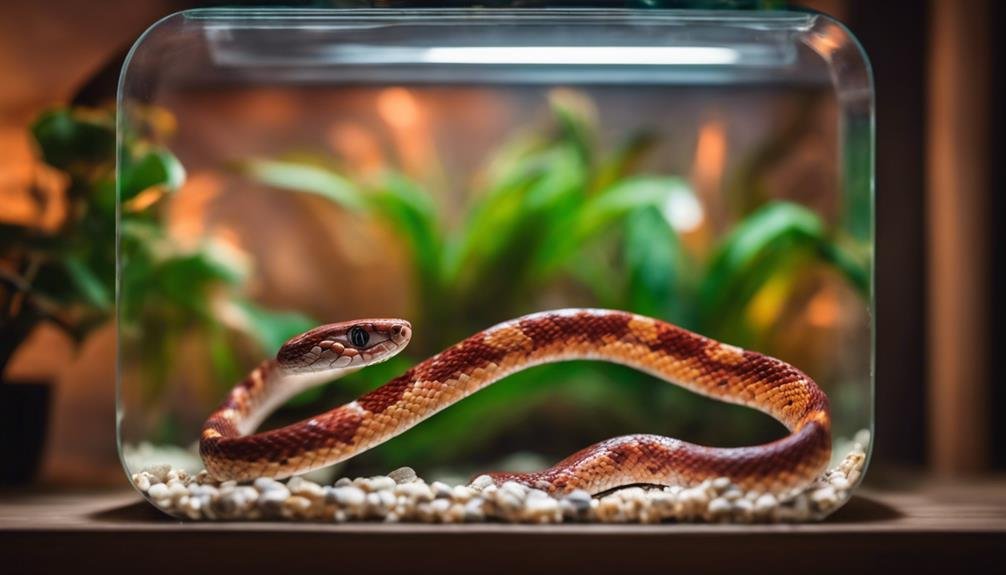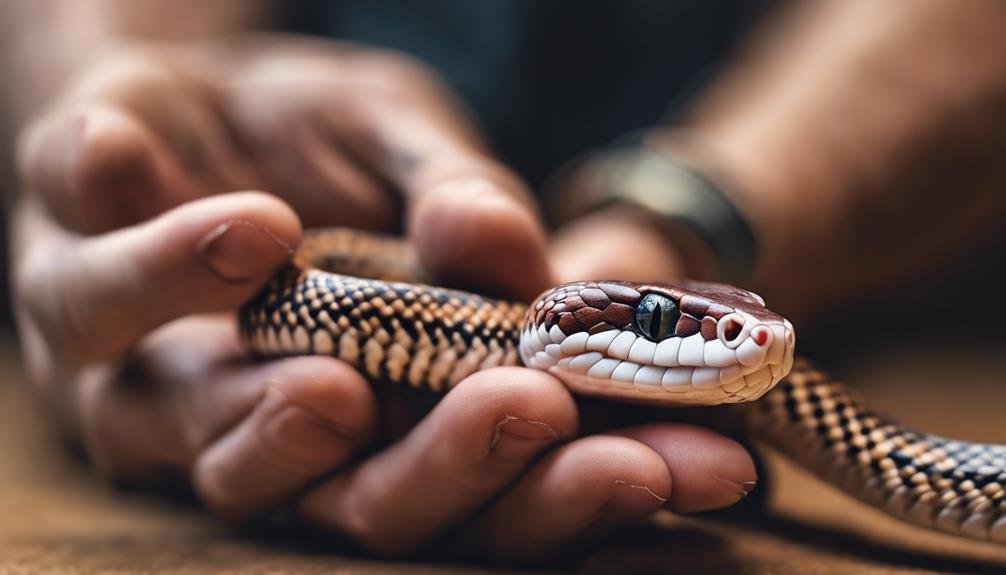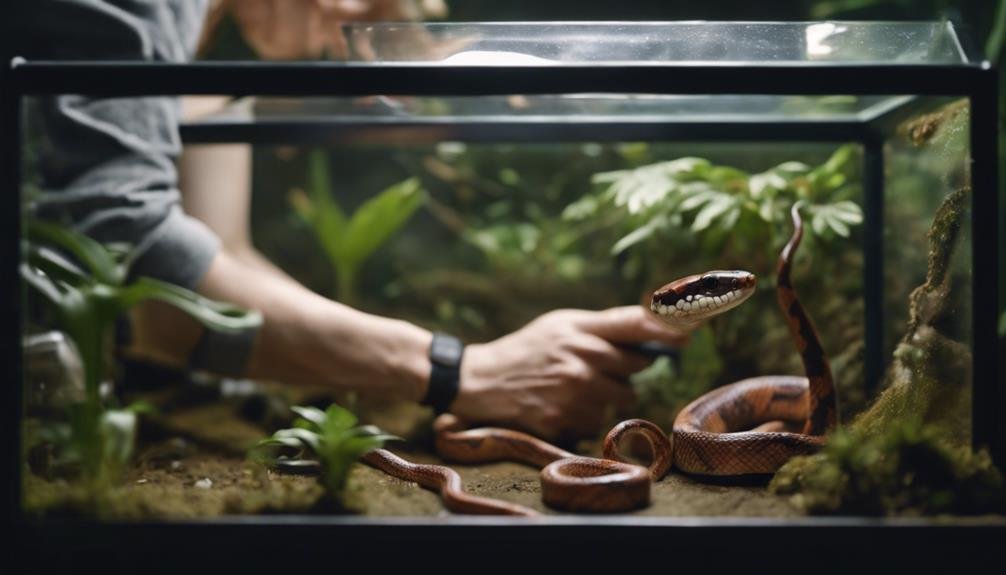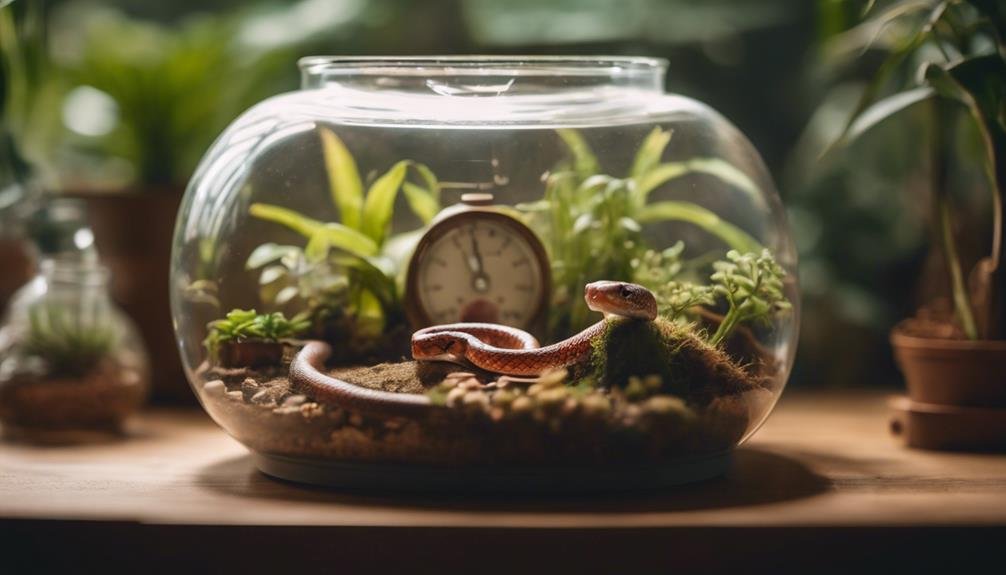If you're considering the rewarding journey of keeping a corn snake, you'll find that it's not just about providing a tank and some food. Setting up the perfect habitat involves understanding the essential balance between temperature, humidity, and space, ensuring your new reptilian friend thrives. But how do you strike the right balance? And what about their diet and the importance of regular handling to build trust? You might be wondering where to start or how to improve your current care routine. Let's explore the essentials together, uncovering the keys to a healthy, happy corn snake that go beyond the basics.
Key Takeaways
- Ensure the vivarium is spacious and maintains a temperature gradient.
- Provide UVB lighting and a consistent heat source, especially at night.
- Offer a diet of thawed frozen rodents, adjusting frequency with age.
- Handle gently to foster trust and allow for socialization.
- Conduct regular health check-ups and spot clean the enclosure daily.
Corn Snake Overview
Among the most beginner-friendly reptiles, corn snakes stand out for their docile nature and vibrant color patterns. If you're venturing into the world of reptile care, a corn snake makes an excellent choice. Known for their even-tempered disposition, these snakes are well-suited for those new to snake care. Their name, intriguingly, comes from the distinctive maize-like pattern on their belly scales, adding an interesting tidbit to share about your pet.
Corn snakes offer a palette of colors and patterns, ensuring you'll find one that captivates your interest. This variety not only makes them visually appealing but also allows for a personal touch in choosing your pet. When it comes to Corn Snake Care, it's reassuring to know that these reptiles can be a long-term companion, with a lifespan extending over 20 years with proper care.
Females typically grow larger than males, reaching lengths of 4 to 6 feet, yet they remain manageable due to their docile nature. Importantly, corn snakes are usually housed alone, reducing the complexity of care for beginners. This aspect simplifies the setup and maintenance, allowing you to focus on enjoying the experience of your beginner snake without the worry of social stressors.
Setting Up the Habitat
When setting up the habitat for your corn snake, it's essential to choose the right enclosure and manage the temperature and humidity meticulously.
You'll need a vivarium that's big enough for your snake to stretch out fully, with a heat source to create a warm basking area.
Ensuring these elements are in place will make your corn snake's new home both safe and comfortable.
Choosing the Right Enclosure
Selecting the appropriate vivarium for your corn snake is essential, as it should match the length of the snake to allow for full stretching. When you're setting up their habitat, the enclosure's size matters greatly for their care, especially as corn snakes shed and grow.
Make sure the enclosure is at least one-third of the snake's length in width and height, using a secure material that retains heat well and prevents escape. A thermogradient is vital; install a heat lamp at one end to create a temperature gradient, ensuring your snake can regulate its body temperature.
The basking zone temperature should be maintained between 28 to 30 degrees Celsius, allowing your corn snake to thrive in a comfortable environment.
Ideal Temperature and Humidity
To safeguard your corn snake's well-being, it's important to uphold a habitat with a temperature gradient. This gradient should feature a basking spot around 90°F and humidity levels between 40% to 60%. Such a balance supports their skin health and aids in digestion of food.
Incorporate a nighttime heat source like a heat mat to maintain the essential temperature gradient, necessary for your snake habitat. Use substrates such as Cypress Mulch to retain humidity, and ensure the enclosure has proper ventilation to avoid moisture buildup.
Equip the habitat with a UV tube for simulated sunlight, climbing branches for exercise, and a reptile water bowl to keep your corn snake hydrated. These elements combined create a conducive environment, promoting a healthy and active lifestyle for your corn snake.
Temperature and Lighting


Maintaining your corn snake's thriving requires keeping a basking spot temperature around 90°F during the day and providing appropriate nighttime heat sources. It's vital to establish a temperature gradient within the enclosure, ensuring your snake can regulate its body temperature by moving between warmer and cooler areas. Nighttime temperatures should drop slightly to mimic natural conditions, but always remain above 70°F to prevent your pet from getting too cold.
UVB lighting plays a supporting role in your corn snake's health, aiding in calcium absorption. Although corn snakes can absorb calcium without UVB, incorporating a 5% T8 UVB tube mounted at the back of the enclosure can benefit their overall well-being. This setup ensures they receive adequate UV exposure without overdoing it.
| Key Requirement | Importance |
|---|---|
| Basking Spot Temperature | Essential for daytime heat regulation |
| Nighttime Heat Sources | Maintains proper temperatures after dark |
| UVB Lighting | Supports calcium absorption and overall health |
Diet and Nutrition
Feeding your corn snake a proper diet is essential for its health and longevity. Caring for reptiles, especially corn snakes, requires understanding their dietary needs at different stages of their life. Whether you're tending to Juvenile Corn Snakes or Adult Corn Snakes, the approach to feeding varies.
- Juvenile Corn Snakes – These younger snakes have faster metabolisms and should be fed thawed frozen rodents, appropriately sized, weekly. This supports their rapid growth until they're fully grown.
- Adult Corn Snakes – Once fully grown, the frequency of feeding can be reduced to once every two weeks. Adult snakes require larger, appropriately sized frozen food to maintain their health without overfeeding.
- Monitoring Weight – It's essential to adjust feeding schedules based on the snake's weight. Overfeeding can lead to health issues, just as much as underfeeding can.
- Hydration – Water should always be available and fresh. The importance of hydration in the diet of corn snakes can't be overstated.
Corn snakes, being carnivorous, thrive on a diet of thawed frozen rodents. By ensuring snakes are fed appropriately sized meals and always have access to water, you're laying the foundation for a healthy, happy reptile.
Handling and Socialization


Building a bond with your corn snake through gentle handling and regular socialization is essential for its well-being. To foster trust and minimize stress, it's important to handle your corn snake with care. This gentle approach will help your snake become more accustomed to human interaction, making the socialization process smoother for both of you. Remember, right after feeding isn't the best time for handling, as this can lead to regurgitation, causing unnecessary stress for your snake.
When you do handle your snake, use slow movements and allow it to explore your hands and arms. This exploration is key to building a positive experience and further strengthening your bond. Slow, predictable movements are less likely to startle your snake, ensuring a calm and stress-free interaction.
Supervising interactions with children is also essential to guarantee safe handling practices are always followed. Kids can be naturally curious and sometimes a bit rough, so teaching them how to interact with your corn snake gently is important for the safety and comfort of your pet. By incorporating these practices, you'll create a nurturing environment where your corn snake can thrive and feel secure.
Health and Veterinary Care
Moving on from handling and socialization, it's vital to focus on your corn snake's health and the importance of veterinary care.
You'll need to keep an eye out for common illness symptoms, like wheezing or lethargy, and make sure to schedule regular health check-ups.
This proactive approach can help catch any issues early, keeping your snake healthy and happy.
Regular Health Check-Ups
To ensure your corn snake remains healthy, it's important to schedule annual health check-ups with a reptile veterinarian. These visits are crucial for several reasons:
- Early Detection: Regular veterinary visits help spot early signs of illness, which is essential for prompt treatment.
- Prevention: Vaccinations and treatments recommended by your vet can prevent certain health issues, keeping your snake free from carriers of infectious diseases.
- Professional Insight: Professional health check-ups can address and prevent common health problems, ensuring your corn snake's long-term health and vitality.
- Expert Advice: A reptile veterinarian can offer tailored guidance on caring for your specific snake, helping you avoid potential health pitfalls.
Common Illness Symptoms
Be aware of symptoms such as wheezing or lethargy in your corn snake, as these can indicate underlying health issues. Monitoring the shedding process is vital; improper shedding can signal health problems.
Always check for mites or ticks during handling, as these parasites can seriously affect your snake's health. Maintaining proper temperature gradients in the enclosure is essential for their well-being.
If you notice any signs of illness, don't hesitate to seek veterinary care. Prompt action is key to addressing health issues effectively. Remember, symptoms of illness in corn snakes, like lethargy and wheezing, demand your attention to guarantee their health and happiness.
Keep a close eye on their shedding process and be vigilant for mites or ticks to keep your corn snake thriving.
Cleaning and Maintenance


Maintaining your corn snake's habitat clean is essential for its health and well-being. Here's how you can make sure your pet lives in a hygienic environment that supports its overall health and happiness:
- Spot Clean Daily: Make it a routine to spot clean your corn snake's enclosure every day. This means removing any waste and soiled bedding as soon as you see it. It prevents the buildup of harmful bacteria and keeps the habitat looking and smelling fresh.
- Full Cage Clean Monthly: Every four weeks, perform a full cage clean. This involves taking everything out of the enclosure, using reptile-safe disinfectants to clean every surface, and then putting everything back in. This deep clean is vital for maintaining cleanliness and hygiene.
- Change Bedding Material: A few times per year, replace the bedding material entirely to prevent bacterial buildup. This keeps the habitat well-maintained and safe for your snake.
- Use Reptile-Safe Disinfectants: When cleaning the enclosure, always use disinfectants that are safe for reptiles. This ensures that you're not introducing any harmful chemicals that could affect your snake's well-being.
Following these steps will help you keep your corn snake's habitat clean and well-maintained, contributing significantly to its overall health and well-being.
Breeding Basics
If you're considering breeding your corn snake, it's crucial to understand that females typically reach sexual maturity at about 2 to 3 years of age. The breeding season for these reptiles usually rolls around in the spring. During this time, you'll want to be well-versed in the breeding basics to make sure everything goes smoothly.
Once you've successfully paired a male and female, keep an eye out for signs that your female is gravid. Gravid females may start looking for a suitable nesting site to lay their eggs. It's your job to provide an appropriate space for egg laying. Typically, a gravid female will lay between 10 to 30 eggs.
After the egg laying, comes the incubation period, which lasts about 60 to 65 days. During this time, maintaining the right temperature and humidity in the incubator is crucial for the development of the eggs.
Once the hatchlings emerge, they're entirely independent and require no parental care. These young snakes are ready to start their lives right out of the egg, eating and shedding on their own. Understanding these breeding basics ensures you're prepared for every stage of your corn snake's reproductive process.
What Should I Keep in Mind About the Necessary Requirements When Feeding My Corn Snake?
When feeding a corn snake, tricks to keep in mind are choosing the right size of prey, maintaining a strict feeding schedule, and providing a quiet, stress-free environment. It’s important to monitor your snake during feeding and handle them carefully to avoid regurgitation. Follow these guidelines for a healthy pet.
Conclusion
To sum up, caring for a corn snake isn't too hard if you've got the basics down. Make sure their habitat's cozy, with the right temperature and light.
Feed 'em a proper diet, and don't forget to bond through regular handling. Keep their space clean and check on their health often.
If you're thinking about breeding, prep well for that too. Follow these steps, and you'll have a happy, healthy corn snake by your side.


